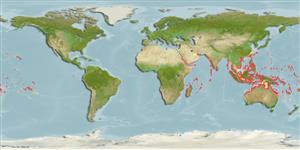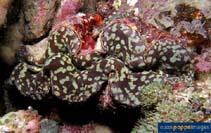Tridacna maxima (Röding, 1798)
Elongate giant clam| Native range | All suitable habitat | Point map | Year 2050 |

|
| This map was computer-generated and has not yet been reviewed. |
| Tridacna maxima AquaMaps Data sources: GBIF OBIS |
Classification / Names ชื่อสามัญ | ชื่อพ้อง | CoL | ITIS | WoRMS
Bivalvia | Cardiida | Cardiidae
Environment: milieu / climate zone / ระดับความลึก / distribution range นิเวศวิทยา
เกี่ยวกับหินโสโครก; ไม่มีการอพยพย้ายถิ่น (อ้างอิง 348); กร่อย; ระดับความลึก 0 - 35 m (อ้างอิง 348). Tropical; 23°C - 30°C (อ้างอิง 102835); 28°N - 37°S, 31°E - 128°W
Distribution ประเทศต่างๆ | พื้นที่จำแนกตาม FAO | ระบบนิเวศหลายระบบ | การปรากฏขึ้น,การเกิดขึ้น,พบ | การแนะนำ
Indo-Pacific: Egypt to Pitcairn Islands and Ogasawara, Japan to Lord Howe Island.
Length at first maturity / ขนาด / Weight / Age
วัยเจริญพันธุ์: Lm ?, range 6 - 13 cm Max length : 41.7 cm SHL เพศผู้/กระเทย; (อ้างอิง 117184); common length : 25.0 cm SHL เพศผู้/กระเทย; (อ้างอิง 348)
Short description สัณฐานวิทยา
Life cycle and mating behavior วัยเจริญพันธุ์ | การสืบพันธุ์ | การวางไข่ | Eggs | ความดกของไข่ | Larvae
Main reference
อ้างอิง | ผู้ประสานงาน | ผู้ร่วมมือ
SAUP Database 2006 SAUP Database. www.seaaroundus.org. (อ้างอิง 356)
IUCN Red List Status
(อ้างอิง 130435: Version 2025-1)
CITES status (อ้างอิง 108899)
CMS (อ้างอิง 116361)
Threat to humans
Human uses
การประมง: การค้า
FAO - การเพาะเลี้ยงสัตว์น้ำ: production; | FishSource | ทะเลรอบๆเรา
เครื่องมือ
ข้อมูลเพิ่มเติม
Max. ages / sizes
Length-weight rel.
Length-length rel.
Length-frequencies
Mass conversion
อุดมสมบรูณ์
แหล่งที่มาจากอินเตอร์เน็ต
BHL | BOLD Systems | CISTI | DiscoverLife | FAO(; publication : search) | Fishipedia | GenBank (genome, nucleotide) | GloBI | Gomexsi | Google Books | Google Scholar | Google | PubMed | แผนภูมิชีวิตแบบต้นไม้ | Wikipedia (Go, ค้นหา) | บันทึกทางด้านสัตววิทยา



